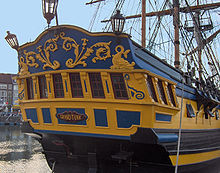| Revision as of 03:28, 24 December 2008 view sourceOhnoitsjamie (talk | contribs)Edit filter managers, Autopatrolled, Administrators261,612 editsm Reverted edits by Jwakizzle (talk) to last version by PrimeHunter← Previous edit | Revision as of 07:01, 22 January 2009 view source Brother Officer (talk | contribs)798 editsm →poop cabin: is below the poop deckNext edit → | ||
| Line 3: | Line 3: | ||
| ]'' with poop deck above]] | ]'' with poop deck above]] | ||
| ], as seen from the ]]] | ], as seen from the ]]] | ||
| In ], a '''poop deck''' is a ] that constitutes the ] of a cabin built in the ] (rear) part of the superstructure of a ]. The '''fantail''' is an overhang at the extreme rear of the ship, aft of the poop deck and closer to level with the main deck.<ref>{{cite web |url=http://wordnet.princeton.edu/perl/webwn?s=fantail |title=Wordnet - Fantail |accessdate=2008-05-02}}</ref><ref>{{cite web |url=http://members.tripod.com/~ussoregon/NavalGlossary.html |title=Naval Glossary |accessdate=2008-05-02}}</ref> The name originates from the ] word (''la poupe'')<ref>This is itself derived from the ] word ], the stern of the ]</ref> for ]. This makes the poop deck technically called a stern deck, which in sailing ships was usually elevated as the roof of the stern (or 'after') cabin |
In ], a '''poop deck''' is a ] that constitutes the ] of a cabin built in the ] (rear) part of the superstructure of a ]. The '''fantail''' is an overhang at the extreme rear of the ship, aft of the poop deck and closer to level with the main deck.<ref>{{cite web |url=http://wordnet.princeton.edu/perl/webwn?s=fantail |title=Wordnet - Fantail |accessdate=2008-05-02}}</ref><ref>{{cite web |url=http://members.tripod.com/~ussoregon/NavalGlossary.html |title=Naval Glossary |accessdate=2008-05-02}}</ref> The name originates from the ] word (''la poupe'')<ref>This is itself derived from the ] word ], the stern of the ]</ref> for ]. This makes the poop deck technically called a stern deck, which in sailing ships was usually elevated as the roof of the stern (or 'after') cabin aka "poop cabin". In sailing ships, with the ] at the stern, an elevated position was ideal for both ] and observation of the crew and sails. | ||
| The picture shows the stern of the ship. The deck out of view above the after cabin is the poop deck. On modern, motorized warships, the ship functions which were once carried out on the poop deck are moved to the superstructure in the center of the ship (or the island on the starboard side, in the case of ]). | The picture shows the stern of the ship. The deck out of view above the after cabin is the poop deck. On modern, motorized warships, the ship functions which were once carried out on the poop deck are moved to the superstructure in the center of the ship (or the island on the starboard side, in the case of ]). | ||
Revision as of 07:01, 22 January 2009


In naval architecture, a poop deck is a deck that constitutes the roof of a cabin built in the aft (rear) part of the superstructure of a ship. The fantail is an overhang at the extreme rear of the ship, aft of the poop deck and closer to level with the main deck. The name originates from the French word (la poupe) for stern. This makes the poop deck technically called a stern deck, which in sailing ships was usually elevated as the roof of the stern (or 'after') cabin aka "poop cabin". In sailing ships, with the helmsman at the stern, an elevated position was ideal for both navigation and observation of the crew and sails.
The picture shows the stern of the ship. The deck out of view above the after cabin is the poop deck. On modern, motorized warships, the ship functions which were once carried out on the poop deck are moved to the superstructure in the center of the ship (or the island on the starboard side, in the case of aircraft carriers).
In nautical parlance, "to be pooped" means to have a wave come over the stern from abaft.
Notes
- "Wordnet - Fantail". Retrieved 2008-05-02.
- "Naval Glossary". Retrieved 2008-05-02.
- This is itself derived from the Latin word puppis, the stern of the Argo Navis